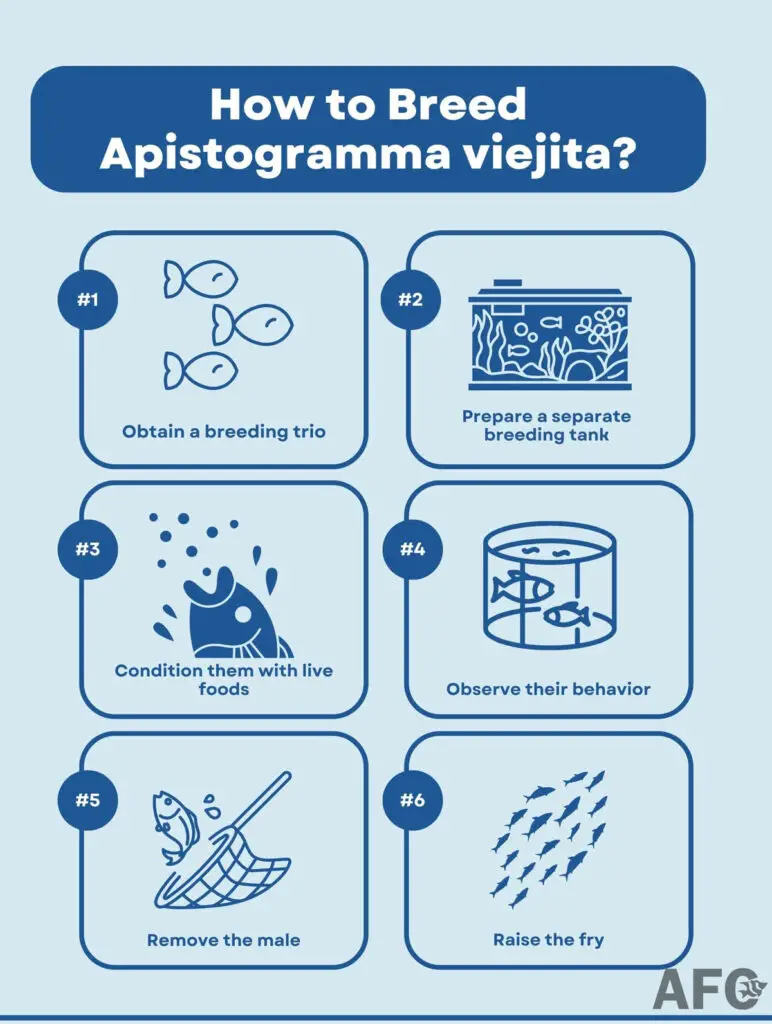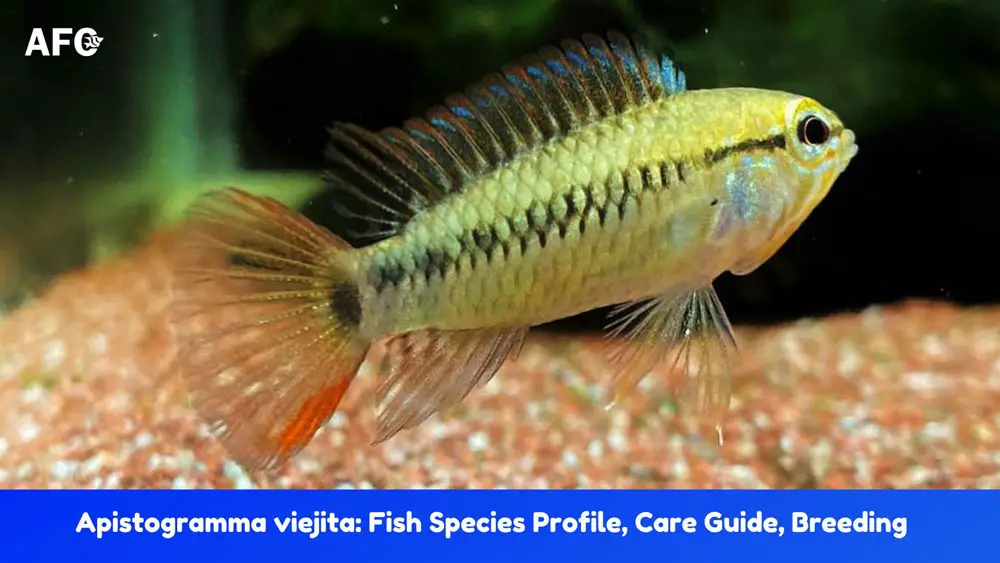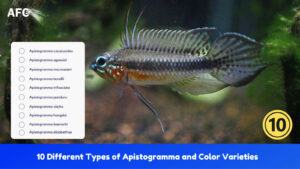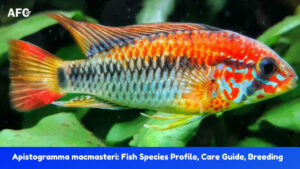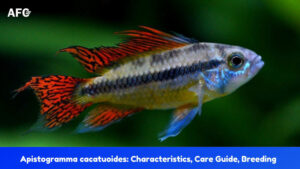Apistogramma viejita is a colorful, medium-sized, aggressive dwarf cichlid that is better for experienced owners than beginners.
These beautiful fish come in two main colors: gold and red. Many experts believe that the specimens labeled as A. viejita in the aquarium trade are actually either Apistogramma macmasteri or a hybrid of A. macmasteri and A. viejita, particularly these colorful domestic strains.
Distinguishing between male and female A. viejita becomes easier as they mature and develop distinctive physical. On the other hand, juvenile fish do not typically exhibit such sexual differences.
Due to their size, temperament, and water parameters requirements, A. viejita do require special care to improve their longevity and optimize breeding success.
Learn more about the species profile of Apistogramma viejita and their care requirements, including tank size, water conditions, aquatic environment, tank mates, dietary preferences, as well as essential reproduction needs.
What Are the Types of Apistogramma viejita?
The most commonly seen color forms of A. viejita are as follows.
- Apistogramma viejita ‘Red’
- Apistogramma viejita ‘Gold’
Apistogramma viejita ‘Red’
A. viejita ‘Red,’ also known as the Red-Neck Apisto, is a color variant of Apistogramma viejita with red coloration on its gills, one-third of its upper body, and caudal fin, contrasted by a golden base, dorsal fin, anal fin, and pelvic fin.
Red is the naturally occurring color of Apistogramma viejita, and the brightness of red varies among different populations in the wild.
In recent years, a super red morph called ‘Apistogramma viejita II’ has gained popularity among enthusiasts, thanks to its vivid red coloration covering the whole body. It is believed that its vibrant full-red coloration is produced by the selective breeding of A. macmasteri with the true A. viejita or with its closely related species A. sp. ‘Rotflecken/Red-flecked’.
Apistogramma viejita ‘Gold’
Virtually all Apistogramma viejita ‘Gold’ sold in pet stores are either a domestic strain of A. macmasteri or a hybrid resulting from crossing A. macmasteri with A. viejita or its relatively closely related species.
These fish are prized for their brilliant golden coloration. The bodies are primarily yellow to golden with lighter-colored red scales on the upper portion and the tips of the dorsal, caudal, and pelvic fins.
What Are the Differences Between A. viejita Versus A. macmasteri?
Below are the key differences between A. viejita Vs. A. macmasteri.
- Dorsal fin: The dorsal fin of A. viejita males has a red edge, whereas it is yellow or gold in A. macmasteri males.
- Tail fin spot: The tail fin spot of A. viejita males is narrow and round- to rectangular-shaped, which is narrow and vertically oval-shaped in A. macmasteri males.
- Caudal fin: The caudal fin of A. viejita males is rounded and does not have extended filaments, while the caudal fin of A. macmasteri males is square-shaped and has longer upper and bottom extensions.
- Lateral line: The lateral line of A. viejita males is accompanied by a narrow, zigzag stripe that runs continuously from the eye to the base of the caudal fin. In contrast, this zigzag stripe is wider and broken into distinct blotches on the anterior half of the body in A. macmasteri males.
- Body shape: A. viejita males feature a slender body compared to the more robust body of A. macmasteri males.
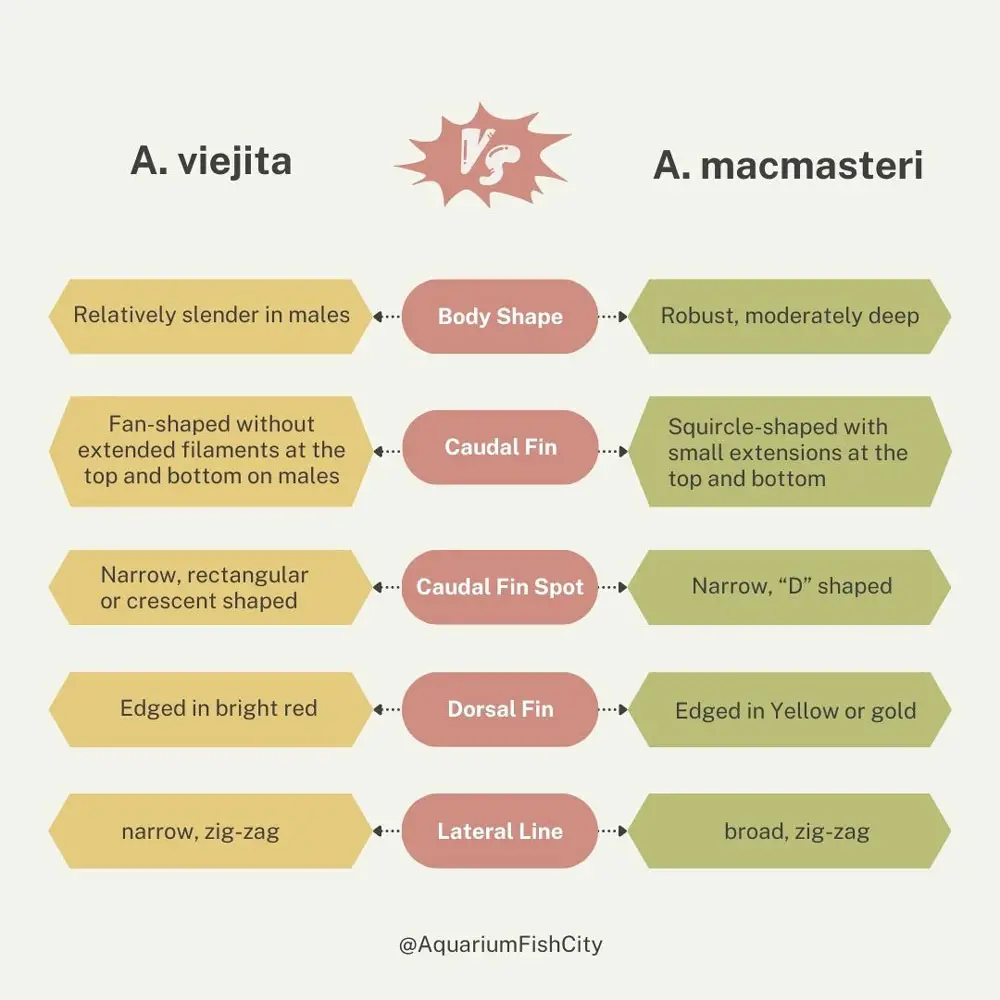
How to Tell a Male From a Female Apistogramma viejita?
Apistogramma viejita males grow a bit larger and more brightly colored than females. They also have extended dorsal spines that are edged in Red. The body of adult females who are ready to spawn will typically display a bright yellow body color accented by black pelvic fin marking.
As with any other apistos, there are no visually obvious sexual differences between juvenile fish smaller than 1.4 inches (3.5 cm).
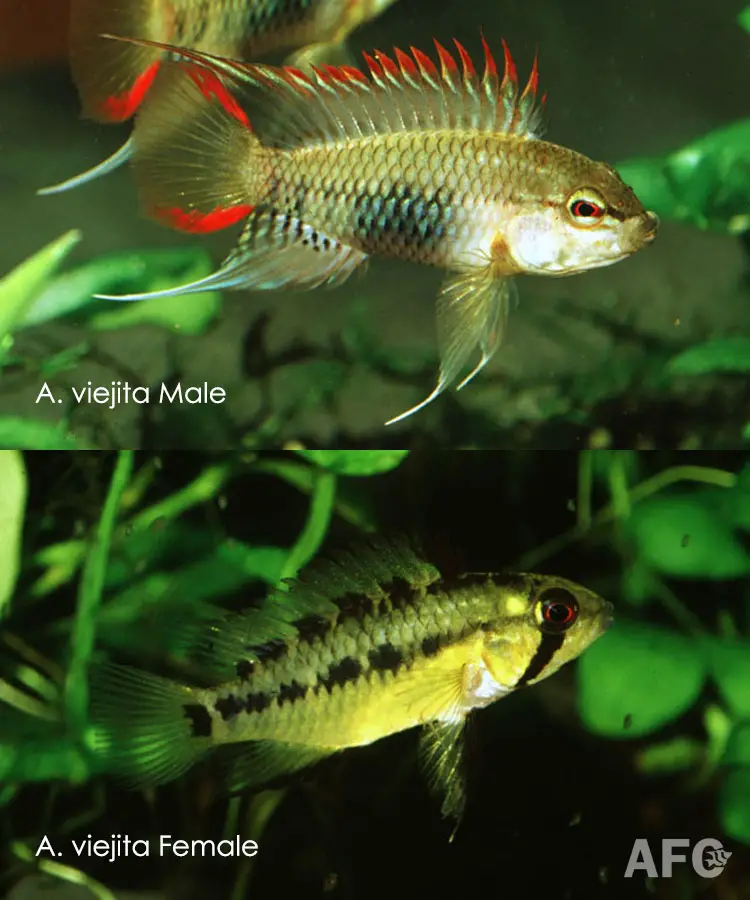
What is the Maximum Size of Apistogramma viejita?
The maximum standard length (SL) of Apistogramma viejita in the wild is 1.2 inches (3 cm), based on the Check List of the Freshwater Fishes of South and Central America by Sven O. Kullander and Roberto E. Reis.
In the home aquarium, A. viejita males can reach up to a standard length (SL) of 2.4 inches (6 cm). Females tend to be a bit smaller, reaching a maximum standard length (SL) of 1.8 inches (4.6 cm).
Are Apistogramma viejita Aggressive?
Yes, A. Viejita is an aggressive member of the Apistogramma family. A. viejita male has a highly polygynous mating system where a male mates with multiple female partners in a single breeding season.
These males behave aggressively toward reproductive competitors in order to gain reproductive access to their females. They also exhibit aggressive behavior towards females that are not yet ready to spawn.
This mating strategy can also lead to female-female aggression, in which A. viejita females react aggressively and solicit the attention of the male. In the wild, the male maintains a harem of several females and intervenes in aggressive interactions.
Due to limited space in aquarium settings, their aggressive behaviors can become frequent. It is recommended to keep at least a trio to prevent a single female from being bullied too often, no matter what type of aquarium you have.
What Is The Minimum Tank Size For Apistogramma viejita?
The minimum tank size for a trio of Apistogramma viejita is 20 gallons Long (75 liters). Each female should have at least 12 inches (30 cm) in diameter as its own territory when kept in a large harem.
How Long Do Apistogramma viejita Live?
The average lifespan of Apistogramma viejita is around two years, according to a 1991 statistical study by Dr. Sven O. Kullander on Apistogramma longevity in 7,532 specimens from 23 different species.
All fish in this study were captive-bred and raised in strict standards on which fish were used. He found that only 8% of all specimens survived for more than 24 months, over 75% of the population died by 18 months, and 33% died within the first year of life. The longest-living specimens survived over 76 months.
Re-creating their natural habitat is the best way to keep A. viejita healthy and increase its chances of living a longer life.
What is The Native Habitat of Apistogramma viejita?
In the wild, Apistogramma viejita is only found in a tributary of the Río Yucao, which is located along the road between Puerto Gaitán and Puerto López, about 34 miles apart. This tributary is in the state of Meta, Colombia.
Their natural habitat is characterized by slow-moving, shallow, clearwater streams along the shoreline, with plenty of submerged vegetation. (Staeck, 2003)
Because of its narrow range, the true Apistogramma viejita is a rare species in the aquarium trade but is relished by specialized breeders. Most captivity-bred strains today are descended from the wild-caught specimens around Puerto Gaitán.
How to Take Care of Apistogramma viejita?
Some basic tips for how to take care of A. viejita are as follows.
- Provide a well-decorated, large aquarium.
- Keep the pristine water quality parameters.
- Mimic their natural habitat.
- Choose compatible tank mates.
- Feed varied live food.
Provide a Well-decorated, Large Aquarium
A well-decorated fish tank refers to an aquarium that is thoughtfully arranged and aesthetically pleasing while also providing a healthy and stimulating environment for the fish and other aquatic inhabitants.
Being an aggressive and territorial dwarf cichlid, Apistogramma viejita requires various decorations to create hiding spots and territories, as well as to help diffuse aggression by breaking the line of sight for bully fish.
When it comes to the size of the aquarium, bigger is always better. A sufficient volume makes it easier to stabilize and maintain optimal water parameters. That’s why we recommend a minimum tank size of 20 gallons Long (75 liters) is recommended for a trio of Apistogramma viejita.
Maintain the Pristine Water Quality Parameters
In the fishkeeping hobby, pristine water quality parameters are the ideal conditions that generally reflect water’s chemical, physical, and biological properties in their natural environment.
The pristine water quality parameters for Apistogramma viejita are as follows.
- Water Temperature: 73 °F to 86 ºF (23º to 30 ºC)
- pH: < 5.5
- GH: < 1 dGH
- KH: < 1 dKH
- Conductivity (EC): around 10 µS/cm
Wild forms of A. viejita do best in a mature tank that has warm, soft, and acidic water. Their tank-raised counterparts will likely adapt to the hardness of the tap water, but they are more vulnerable to bacterial infections in hard (GH > 12 dGH) and alkaline water (pH > 7.0).
To keep your fish healthy, it is important to monitor the water quality parameters, including ammonia, nitrite, temperature, and pH, on a daily basis and perform regular water changes of 10-15 percent every week.
Mimic their Natural Environment
Mimicking a more natural environment of Apistogramma viejita involves creating a biotope aquarium that closely resembles the ecosystems in their homes. For Apistogramma viejita, this can be achieved through the following elements.
- A sand substrate: Fine-grained sand (0.5-1.7 mm grain size) is the safest substrate for all types of Apistogramma due to their sand-sifting feeding behavior.
- Leaf litter: Adding lots of leaf litter on the substrate not only helps to keep the pH low but also provides essential organic matter and nutrients for the fry.
- Live plants: A healthy mix of floating plants and other submersed species can be used to dim the lighting, produce oxygen and absorb nitrate, and provide additional hiding spots for the fish.
- Caves: Plenty of caves formed by rocks, driftwood, overturned flower pots, or half-coconut shells, should be provided as spots to breed or hide just as they would do in their natural habitat.
- Branches: Many branches should also be added for a more natural touch and visual appeal.
Choose Compatible Tank Mates
The best tank mates for Apistogramma viejita depend on the tank type you are keeping them in and the tank size.
- The ideal tank mates for Apistogramma viejita in breeding tanks are pencilfish. Pencilfish (Nannostomus spp.) are a group of small, slender, surface-dwelling freshwater fish that are native to South America. These dither fish are known for their peaceful nature, timid and small size, and unique swimming behavior. Because of their small mouths, they are safe for Apistogramma viejita’s babies.
- The ideal tank mates for Apistogramma viejita in medium-sized community aquariums are small South American tetras, such as Neon Tetra, Cardinal Tetra, Ember Tetra, Rummynose tetra, hatchetfish, rasbora, and small members of catfish, like pygmy corydoras and otocinclus catfish. These peaceful schooling fish share similar water chemistry and will not compete for the same space with Apistogramma viejita. Their confident behavior can change the dynamics of the aquarium, reducing aggression and bullying.
- The compatible tank mates for Apistogramma viejita in medium to large-sized community aquariums include freshwater Angelfish, Keyhole cichlid, and Discus fish. Those are relatively peaceful South American cichlids that will swim in the middle of the water volume and like to hang out with tall plants.
Feed a Varied Live Food
In nature, A. viejita are omnivorous scavengers that feed on both plants and animals. In captivity, they will thrive on a varied diet of live foods, such as baby brine shrimp (BBS), daphnia, bloodworms, glassworms, and mosquito larvae. Live red worms and blackworms should be avoided due to the high risk of parasites and lack of cleanliness.
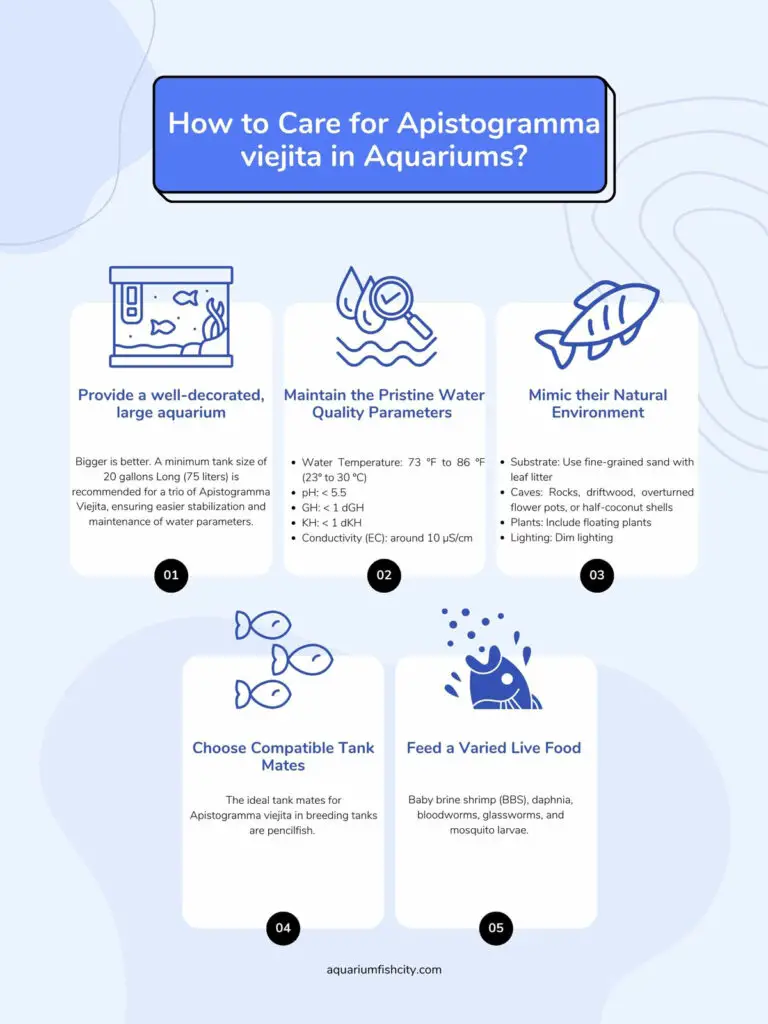
How to Breed Apistogramma viejita?
Here are the guidelines and tips to increase the chances of successful breeding with aquarium-raised Apistogramma viejita.
Step 1: Obtain a Breeding Trio
The best way to establish a mating trio with one male and two females is to purchase a group of at least six juveniles and raise them together. Alternatively, you may be lucky enough to find a great trio ready to breed right online!
Step 2: Prepare a Separate Breeding Tank
- Set up a separate breeding tank with acidic (pH < 7) and moderately soft (dH < 10º) water. The water temperature should be kept around 79 °F (26 ºC).
- As with most Apistos, A. viejita is a secretive cave spawner, so make sure to provide each female with its own spawning cave.
- Consider covering the sides with aquarium backgrounds to block out light and create a more subdued environment in the tank.
- Add a group of pencilfish; Dwarf pencilfish (N. marginatus) and brown pencilfish (N. eques) are great options to act as dither fish.
- Use a sandy substrate.
Step 3: Condition Them With Live Food
Condition the fish with a high-quality live food diet before placing them in the breeding tank. This will help stimulate spawning activity and ensure that they are in prime condition prior to breeding.
Step 4: Observe their Behavior
Once the breeding trio is in the tank, watch the fish to see if the male becomes overly aggressive towards one of the females. In most cases, the female is not ready to spawn yet, but there are several other reasons, including the tank isn’t well structured or the female is choosy when seeking mates.
Try to re-arrange the tank and create more visible territorial boundaries for the female. If the male is still aggressive, remove him and try another male.
You may observe their courtship rituals, such as flaring gills and tail-standing when they are ready to spawn.
The breeding process often occurs secretively until the fry can be seen around the caves. However, the female will lay eggs (50 – 75) inside the caves and then guard them.
Within no more than 3 days, the eggs should hatch. The fry should be able to swim on their own in three to four days.
Step 5: Remove the Male
The male sometimes tries to spawn with the female again right away. If you notice the female chasing the male away from the spawning site every time he approaches, it’s time to remove him from the tank.
Step 6: Raise the Fry
In three to four days, the fry remains small and can only eat the smallest of foods, such as liquid fry food, infusoria, or rotifers. After that, they can be fed with newly hatched brine shrimp. Meanwhile, more frequent water changes will help the fry grow faster.
